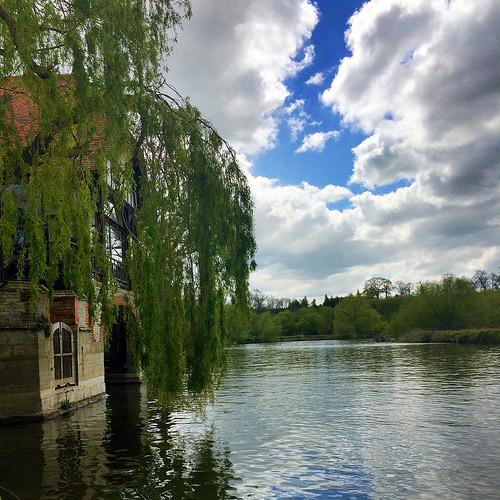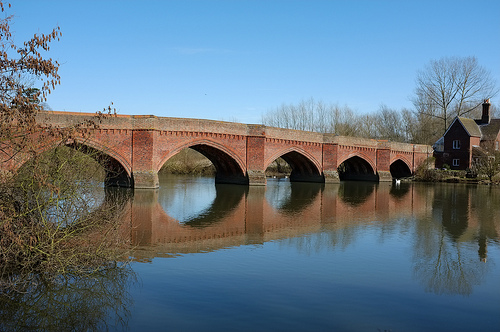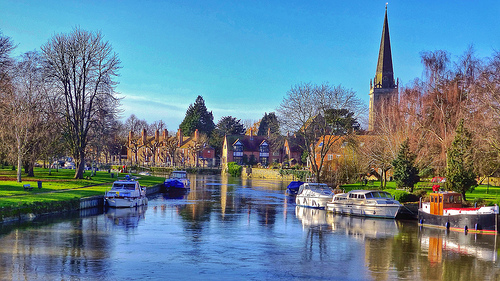Goring to Abingdon (21 miles)
After covering 11 miles in just over 4 hours the day before, I thought to myself I could perhaps do 21 miles in a day. Also, the sun did not seem to set as early as I had previously expected - it is funny how spending too much time in the office, one rarely gets to witness the moment when day becomes night. More importantly, there would be no convenient way to get back to London unless I made it to Abingdon. Trains and buses were few and far between in this part of Oxfordshire.
This turned out to be a) an over-estimation of my ability, and b) an under-estimation of how mud could really slow down progress.
I made an early start. The weather cleared up overnight. The morning mist hovered lazily over the river Thames. I knew this was going to be a glorious day, Suddenly, yesterday's miserable weather seemed like such distant memory. In order to enjoy the best of British weather, one has to endure the worst of British weather.
First stop, Moulsford, a pretty village with red-brick houses. Just to the north of the village, I walked underneath the Moulsford Railway Bridge. If you take a train from London Paddington to Wales, you train will cross the Thames here, over this bridge, which was built by none other than Isambard Kingdom Brunel. Beyond the bridge, the path got pretty narrow, and also very muddy at the same time. I had to constantly drag my feet out of the mud. I estimated that I was going at half the pace I should be going at as a result.
The terrain improved as I approached Wallingford, which had a magnificent church. Beyond Wallingford, I walked another 45 minutes to get to Shillingford, where I found a quiet little corner at the end of Wharf Road to have lunch. This was my favourite spot along the Thames.

Shillingford - my little quiet corner (original image credit)
It was almost the half way point of the walk. I looked at my watch, and thought if I was to make it to Abingdon before 5pm, I had got to step up the pace. So I wasted no time, and soon got to Dorchester where the minor River Thame joins the mighty Thames. Passing Day's Lock, I spent more than an hour skirting the remote riverside meadow. With the landscape being rather featureless, it was hard to tell whether I was moving quick enough. Finally, the village of Clifton Hampden came into the sight, and it was a welcoming sight indeed. The red-brick bridge is a superb example of Victorian Gothic construction, designed by the famous George Gilbert Scott, who is famous for the St Pancras Station, as well as being the grandfather of Giles Gilbert Scott - the architect behind Battersea Power Station, and the iconic red phone box.

Clifton Hampden (original image credit)
The river headed south before returning west. The skyline was dominated by the towers of the Didcot Power Station for the next few miles. Just as the aforementioned Battersea Power Station has become a piece of revered industrial heritage, will the Didcot towers ever enter the pantheon of iconic industrial architecture? I don't think so somehow, but who knows.
Culham is the next village. I made it there just before 4pm, which was good as I knew I would walk from Culham to Abingdon in under an hour. This final stretch certainly felt more difficult than I had expected. My feet were really starting to ache, but I knew I could not slow down as the sun was starting to set. By the time I got to Abingdon, the daylight had almost given away to darkness. I walked up to the last bench before Abingdon Bridge. I had sit on one of these benches before with Sze Kiu.

Abingdon (original image credit)
I literally collapsed onto the bench. My shoulders, my thighs, my feet were hurting. My whole body was hurting. I was happy. I made it - I had never walked 21 miles in a day before.
Reluctantly, I dragged my wounded body away from the bench and made my way to the bus stop to catch the bus to Oxford. I slept very well on the coach back to London.